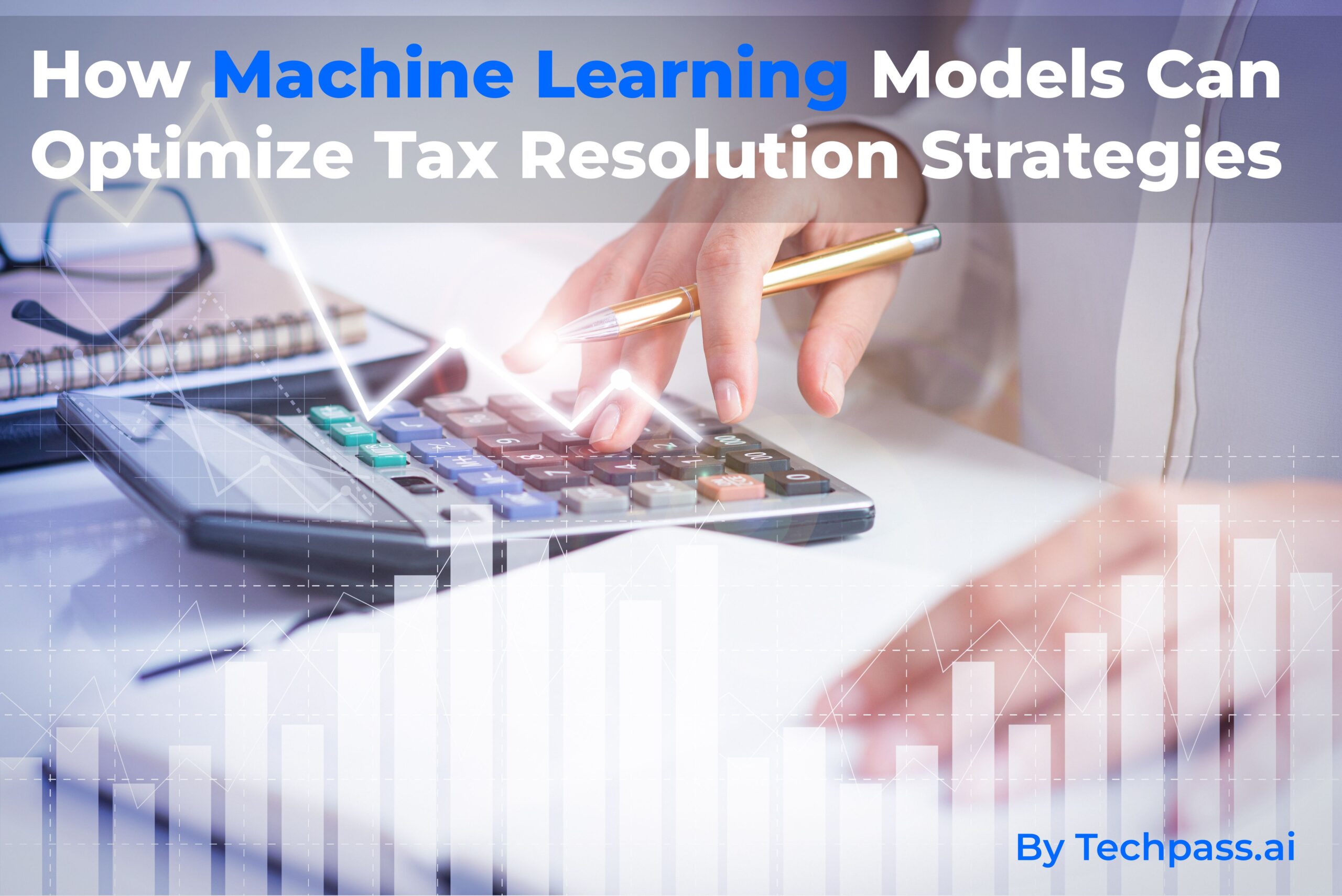
Table of Contents
Introduction
Tax resolution is often a daunting task, riddled with complexities and challenges that can overwhelm even the most seasoned tax professionals. Traditional methods of handling tax disputes and compliance have often proven inefficient, leaving room for errors and prolonged resolution times. However, the advent of machine learning presents a transformative opportunity to optimize tax resolution strategies, making them more efficient, accurate, and tailored to individual needs.
This article aims to provide a deep dive into the mechanics of machine learning in tax resolution, exploring its applications, advantages, and the future it holds for tax professionals and their clients.
Understanding Tax Resolution
Before delving into the impact of machine learning, it’s crucial to define tax resolution. Tax resolution encompasses the range of strategies and procedures employed to address various tax-related issues. This can include:
- Disputes with tax authorities: These may arise due to disagreements over tax liabilities, deductions, or credits.
- Tax audits: The examination of an individual’s or business’s tax return by tax authorities to ensure compliance with tax laws.
- Penalties and interest: Imposed for late payments or non-compliance, which may necessitate negotiation and resolution.
Successful tax resolution aims to minimize liabilities, achieve compliance, and restore peace of mind for taxpayers.
The Role of Machine Learning in Taxation
Machine learning is a branch of artificial intelligence that allows systems to learn from data, identify patterns, and make decisions without explicit programming. In the context of taxation, machine learning can play a pivotal role by providing insights that enhance tax resolution strategies.
Key Areas Where Machine Learning Can Contribute:
- Data Processing: Machine learning (ML) algorithms can analyze large datasets efficiently, uncovering patterns that may not be evident through manual analysis.
- Automation: ML can automate routine tasks, freeing up tax professionals to focus on more strategic aspects of their work.
- Predictive Capabilities: Machine learning can forecast future tax liabilities and potential issues, enabling proactive strategies for resolution.
Enhancing Data Analysis
Data is at the core of tax resolution strategies. With the vast amounts of information that tax professionals handle, machine learning can significantly enhance data analysis capabilities.

Handling Big Data
Taxation involves a multitude of data sources, from financial statements and transaction records to compliance documents. The sheer volume of data can be overwhelming, leading to potential oversight.
Machine learning models are designed to handle big data effectively, employing techniques such as:
- Natural Language Processing (NLP): This allows machines to understand and process human language, making it easier to analyze text-heavy documents such as tax forms and regulations.
- Clustering and Classification: These techniques can group similar data points, helping professionals identify patterns and trends within their tax data.
By automating data analysis, machine learning helps tax professionals quickly identify discrepancies and trends, leading to more informed decision-making.
Predictive Analytics
Predictive analytics is a powerful application of machine learning that enables tax professionals to anticipate future events based on historical data. By analyzing past tax filings and outcomes, machine learning algorithms can predict:
- Future Tax Liabilities: Understanding how current financial activities may impact future tax responsibilities allows businesses to plan accordingly.
- Audit Risks: By identifying patterns that typically lead to audits, tax professionals can take preemptive measures to mitigate risk.
This predictive capability empowers tax professionals to strategize effectively, reducing the likelihood of disputes and enhancing overall compliance.
Automating Routine Tasks
One of the most significant advantages of integrating machine learning into tax resolution is the automation of routine tasks. This not only increases efficiency but also minimizes human error.
Streamlining Document Review
Document review is a time consuming task for tax professionals. Machine learning can expedite this process by:
- Categorizing Documents: ML algorithms can analyze and categorize documents based on their content, identifying which documents are relevant to a particular tax situation.
- Flagging Discrepancies: Advanced algorithms can compare documents against established benchmarks to identify inconsistencies that may warrant further investigation.
This automation allows tax professionals to focus on more complex issues, ultimately leading to quicker resolutions.
Optimizing Data Entry
Data entry errors can have significant ramifications in tax resolution. Machine learning can streamline data entry processes by:
- Reducing Human Errors: Algorithms can verify data against various sources, ensuring accuracy and consistency.
- Enhancing Efficiency: Automating data entry frees up valuable time for tax professionals to engage in higher-level analysis and strategy development.
By optimizing data entry, machine learning minimizes the risk of costly mistakes and enhances the overall quality of tax filings.
Improving Compliance Monitoring
Compliance is a critical aspect of tax resolution. Machine learning can enhance compliance monitoring in several ways.

Real-Time Monitoring
Machine learning models can continuously analyze tax-related data, providing real-time insights into compliance status. This capability allows tax professionals to:
- Stay Updated on Regulations: Tax laws are constantly changing. Machine learning can monitor updates to regulations and assess their impact on compliance.
- Identify Potential Issues Early: Real-time monitoring helps identify compliance issues before they escalate, allowing for timely intervention.
By maintaining a continuous watch on compliance, businesses can avoid penalties and disputes.
Anomaly Detection
Anomaly detection is a critical application of machine learning that helps identify unusual patterns or behaviors in tax data. By establishing a baseline of normal activity, machine learning can flag anomalies that may indicate:
- Fraudulent Activities: Unusual transaction patterns could suggest fraudulent behavior, prompting further investigation.
- Compliance Breaches: Anomalies in data can indicate potential non-compliance, allowing tax professionals to address issues proactively.
This capability enhances the effectiveness of tax resolution strategies by allowing professionals to focus their efforts where they are most needed.
Personalized Tax Strategies
Every taxpayer’s situation is unique, and machine learning can help tailor tax strategies to individual needs.
Tailored Recommendations
Machine learning algorithms can analyze an individual or business’s financial situation and provide personalized tax strategies that align with their specific circumstances. This includes:
- Custom Deductions and Credits: ML can identify potential deductions and credits based on unique financial profiles, maximizing savings.
- Strategic Timing: Recommendations can be made regarding the optimal timing for income recognition or deductions, based on predictive analytics.
By offering tailored recommendations, machine learning enhances the effectiveness of tax strategies, leading to better outcomes for clients.
Scenario Analysis
Machine learning allows tax professionals to run various “what-if” scenarios, evaluating the potential outcomes of different tax strategies. This enables:
- Informed Decision-Making: Professionals can assess the impact of various strategies on tax liabilities, helping them choose the most beneficial approach.
- Risk Assessment: By simulating different scenarios, tax professionals can identify risks associated with specific strategies and mitigate them accordingly.
This capability empowers tax professionals to make data-driven decisions that optimize tax resolutions.
Enhancing Decision Making
The integration of machine learning into tax resolution not only streamlines processes but also enhances decision-making capabilities.
Data-Driven Insights
Machine learning models provide tax professionals with valuable insights derived from data analysis. This leads to:
- Better Strategic Planning: Insights gained from machine learning can inform strategic planning, helping businesses anticipate challenges and opportunities.
- Increased Accuracy: Data-driven decisions are often more accurate than those based on intuition, reducing the likelihood of costly mistakes.
By leveraging machine learning for decision-making, tax professionals can enhance their effectiveness in resolving tax issues.
Risk Assessment
Risk assessment is a critical component of tax resolution. Machine learning can enhance risk assessment through:
- Quantitative Analysis: Algorithms can quantify the risk associated with different tax strategies, allowing professionals to choose safer options.
- Historical Comparisons: By analyzing past tax cases, machine learning can identify factors that contributed to successful resolutions or disputes.
This analytical approach enables tax professionals to navigate the complexities of tax resolution with greater confidence.
Case Studies: Success Stories in Tax Resolution
Several organizations have successfully integrated machine learning into their tax resolution strategies, resulting in significant improvements. Here are a few noteworthy examples:
A Global Financial Institution
A major global bank implemented machine learning to enhance its tax compliance processes. By analyzing historical data and identifying patterns leading to disputes, the bank reduced its audit exposure by 30%. The implementation of real-time monitoring also enabled the bank to stay compliant with evolving tax regulations.
A Leading Accounting Firm
A leading accounting firm adopted machine learning to automate document review for its tax clients. The firm was able to reduce the time spent on document review by 50%, allowing tax professionals to focus on higher-value advisory services. This efficiency not only improved client satisfaction but also enhanced overall productivity.
A Tech Startup
A tech startup leveraged machine learning to create personalized tax strategies for its employees. By analyzing individual financial situations, the startup was able to identify unique deductions and credits, resulting in significant tax savings for its team members. This approach not only improved employee morale but also strengthened the company’s reputation as an employer.
Challenges and Considerations
While the benefits of machine learning in tax resolution are significant, several challenges must be addressed:
Data Privacy
Handling sensitive financial data raises privacy concerns. Tax professionals must ensure that they adhere to regulations governing data protection, safeguarding client information from unauthorized access.

Implementation Costs
The initial investment in machine learning technology and training can be substantial. Organizations must weigh the costs against the potential benefits to determine the feasibility of integration.
Skill Gap
The successful implementation of machine learning requires tax professionals to acquire new skills. Training may be necessary to ensure that staff members are equipped to utilize ML tools effectively.
The Future of Tax Resolution with Machine Learning
The future of tax resolution is poised for transformation as machine learning technologies continue to evolve. Key trends to watch for include:
- Increased Automation: As machine learning becomes more sophisticated, we can expect greater automation of routine tasks, allowing tax professionals to focus on strategic initiatives.
- Enhanced Personalization: The ability to analyze individual financial situations will lead to even more personalized tax strategies, optimizing resolutions for clients.
- Integration with Other Technologies: Machine learning will likely be integrated with other emerging technologies, such as blockchain, to enhance data security and transparency in tax resolution processes.
As tax professionals embrace these innovations, the landscape of tax resolution will become more efficient, effective, and tailored to the unique needs of taxpayers.
Conclusion
Machine learning models are revolutionizing tax resolution strategies by enhancing data analysis, automating routine tasks, improving compliance monitoring, and providing personalized recommendations. The integration of these technologies empowers tax professionals to navigate the complexities of taxation with greater efficiency and accuracy.
While challenges exist, the potential benefits of machine learning far outweigh the risks. As the technology continues to evolve, tax professionals who adopt these innovations will be better positioned to deliver optimal outcomes for their clients.
For more information, visit techpass.ai.
Frequently Asked Questions (FAQs)
1. What is tax resolution?
Tax resolution refers to the processes and strategies used to address tax-related issues, including disputes, audits, and compliance.
2. How does machine learning help in tax compliance?
Machine learning helps by analyzing large volumes of data to identify trends, predict future liabilities, and monitor compliance in real-time.
3. What are the benefits of automating document review in tax resolution?
Automating document review reduces the time spent on manual processes, minimizes errors, and allows tax professionals to focus on more complex tasks.
4. Can machine learning predict future tax liabilities?
Yes, machine learning can analyze historical data to make predictions about future tax liabilities, allowing for proactive management.
5. What challenges does machine learning face in tax resolution?
Challenges include data privacy concerns, implementation costs, and the need for tax professionals to acquire new skills to effectively use ML tools.
6. How can machine learning models optimize tax strategies?
Machine learning models optimize tax strategies by analyzing data to identify trends and providing predictive insights. They automate routine tasks like data entry and document review, enhance compliance monitoring by detecting anomalies, and recommend personalized strategies based on individual financial profiles. This leads to improved efficiency and reduced risks for taxpayers.
If you found our content helpful don’t forget to share it on your social media: Twitter

